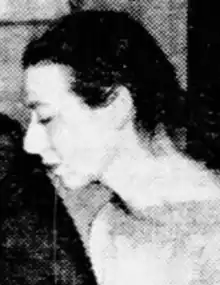Marian Hannah Winter
Marian Hannah Winter (March 20, 1910 – December 15, 1981) was an American musicologist and dance historian. She has been called one of "the [two] foremost names in American dance history."[1]
Marian Hannah Winter | |
|---|---|
 Marian Hannah Winter, from a 1939 newspaper | |
| Born | March 20, 1910 New York City |
| Died | December 15, 1981 Paris, France |
| Occupation | Dance historian |
Early life and education
Winter was born in New York City, the daughter of Ernest Winter and Rose Rosenbluth Winter. Her father and maternal grandparents were all immigrants from central Europe; her mother was a policewoman[2] who collected theatrical sketches.[3]
She attended Radcliffe College.[4][5]
Career
In 1939, Winter worked for the Federal Music Project in New York City, and assembled an exhibit on "Art Scores for Music" at the Brooklyn Museum,[6] called "the first international exhibition of scores for cabaret and concert hall music".[7]
In the 1940s, dance historian Lincoln Kirstein solicited Winter to write for Dance Index, a magazine he headed. In contrast to Kirstein's analytical or polemical approach to history, Winter was more of an archivist.[1] One of Winter's most influential works is "Juba and American Minstrelsy", published in 1947.[8] The article sketches the life of Master Juba, a black American dancer active in the mid-19th century. Winter argues that Juba introduced African elements to American dance forms and, in the process, created a new, distinctly American style. The article thus attempts to "[re-appropriate] for black culture what is otherwise generally seen as racist theft."[9]
Winter moved to France in her later years, where she worked as a translator and collected art and ephemera related to fairs and festivals.[3] There, she published The Theater of the Marvels in both English- and French-language editions.[10][11] She was awarded a Guggenheim Fellowship in 1974.[12] Of her 1974 book, The Pre-Romantic Ballet, one reviewer said that "Some historians have an ability to write about the remote past as if they were giving a first-hand account of personal experience. Marian Hannah Winter is one of them."[13]
Publications
- "American Theatrical Dancing from 1750 to 1800" (1938)[14]
- Art Scores for Music (1939)
- "The Function of Music in Sound Film" (1941)[15]
- "Augusta Maywood" (1943)[16]
- "Juba and American Minstrelsy" (1947)[17]
- The Theater of the Marvels (1964, with a preface by Marcel Marceau)[10]
- The Pre-Romantic ballet (1974)[18]
Personal life and legacy
Winter used a wheelchair in her later years, to manage the effects of a progressive neurological condition.[3] She died in Paris.[1] There is a collection of her papers, including correspondence, notebooks, and photographs, at the Houghton Library, Harvard University.[19] The Marian Hannah Winter Professorship in Theatre and Dance Studies at the University of Wisconsin-Madison was named in her memory. In 1985, items from her collection of fairground memorabilia were displayed at the Pusey Library in Cambridge.[3]
Notes
- Kisselgoff, Anna (February 2, 1986). "Dance View; Dance History Is Mostly a European Affair", The New York Times. Accessed March 28, 2008.
- "Woman Writer Injured in Crash". Daily News. 1942-08-27. p. 19. Retrieved 2023-03-24 – via Newspapers.com.
- Cash, Debra (1985-11-28). "The marvelous world of fairground art". The Boston Globe. p. 158. Retrieved 2023-03-24 – via Newspapers.com.
- "In Response to". The Brooklyn Daily Eagle. 1939-04-08. p. 18. Retrieved 2023-03-24 – via Newspapers.com.
- Radcliffe College, Alumnae Directory (1934): 281, lists Winter as a student from 1927 to 1929, and an ex-member of the class of 1931, but not as a graduate.
- "Art and Music". Daily News. 1939-01-24. p. 409. Retrieved 2023-03-24 – via Newspapers.com.
- "Forgotten Art Revived in Museum Exhibit". The Brooklyn Daily Eagle. 1939-01-14. p. 9. Retrieved 2023-03-24 – via Newspapers.com.
- Sullivan, John Jeremiah (Winter 2019). "Talking Drums". Oxford American. Retrieved 2023-03-24.
- Johnson, Stephen (1999). "Past the Documents, to the Dance: The Witness to Juba in 1848", on The Juba Project. Originally published in The Performance Text. Legal Press. Online version accessed March 28, 2008.
- Winter, Marian Hannah. The Theatre of Marvels. New York: B. Blom, 1964.
- Wagner, David F. (1965-10-10). "Wicked Genies, Fantastic Plots Vividly Recalled". The Post-Crescent. p. 84. Retrieved 2023-03-24 – via Newspapers.com.
- "Marian Hannah Winter". John Simon Guggenheim Memorial Foundation. Retrieved 2023-03-24.
- Kriegsman, Alan M. (1976-11-25). "Books reflect new interest in the dances". The Honolulu Advertiser. p. 112. Retrieved 2023-03-24 – via Newspapers.com.
- Winter, Marian Hannah (1938). "American Theatrical Dancing from 1750 to 1800". The Musical Quarterly. XXIV (1): 58–73. doi:10.1093/mq/xxiv.1.58. ISSN 0027-4631.
- Winter, Marian Hannah (1941). "The Function of Music in Sound Film". The Musical Quarterly. 27 (2): 146–164. doi:10.1093/mq/XXVII.2.146. ISSN 0027-4631. JSTOR 739462.
- Augusta Maywood. Ballet Society. 1943.
{{cite book}}: CS1 maint: others (link) - Winter, Marian Hannah. Juba and American Minstrelsy. Dance Index-Ballet Caravan, 1947.
- Winter, Marian Hannah (1974). The pre-Romantic ballet. London: Pitman. ISBN 0-273-00334-8. OCLC 1910006.
- "Collection: Marian Hannah Winter papers". Houghton Library, Harvard University. Retrieved 2023-03-24.